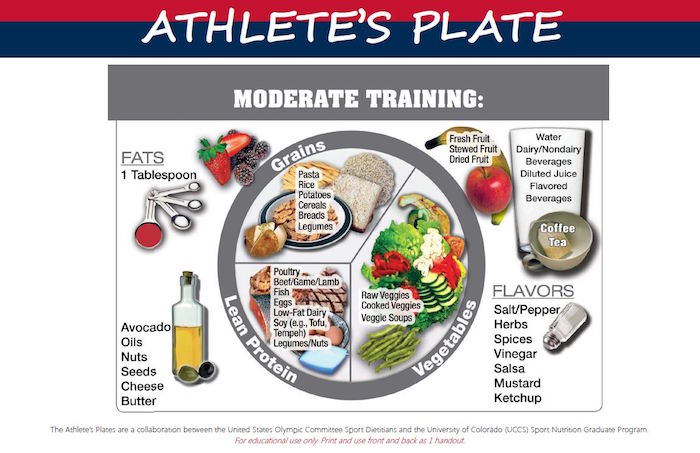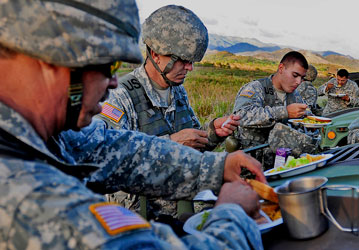What the average Service Member eats might surprise you. Good nutrition is one factor that enhances your ability to focus, increases energy, and keeps you fueled for the operational duties of your day. This is especially important for all Service Members, who are Warfighters or “warrior athletes,” regardless of duties. The demands of military service, training, and missions are unlike those of any athletic endeavor. Food is fuel to help muster strength and endurance—physical and mental—to succeed. In addition, the "right" foods can help with recovery after an intense workout or injury—getting you back to your best. However, the majority of Service Members don’t eat a high-performance diet to support the “readiness” priority.
The typical Warfighter diet
A recent survey of almost 15,000 Soldiers showed how few consume nutrient-rich foods.
|
|
Dietary Guidelines for Americans recommendations |
% Soldiers meeting recommended amounts |
|---|---|---|
|
Fruits |
2 servings/day |
38.7% |
|
Vegetables |
2 servings/day |
22.2% |
|
Whole grains |
2–3 servings/day |
16.8% |
|
Dairy |
3 servings/day |
17.3% |
|
Fish |
2–3 servings/week |
46.6% |
Eating poorly doesn’t just hurt performance; it also can lead to being overweight and even obese. However, you can change that! Keep reading to learn how.
A better Warfighter diet
To get started, ask yourself, “Is what I’m eating helping or hindering my performance?” If you’re feeling low in energy, underperforming in the gym, or struggling through your workday, then choose better “fuel.” With performance optimization being the “why,” you also need to focus on what, how much, when, and where.

- What? For optimal nutrition, create an Athlete’s Plate by choosing nutrient-dense foods from the 5 food groups: fruits, vegetables, grains, protein, and dairy, as well as oils. At mealtimes, select items from at least 3 of the food groups—to make a mixed meal that contains carbs, protein, and healthy fats—to maintain energy for strong and effective training sessions. Warfighters should strive for this pattern at all meals, not just before a mission or training session. For an example, see the High-Performance Eating vs. Low-Performance Eating infographic.
- How much? Select the optimal portions for your body, training schedule, health conditions, and weight goals. Your portions might differ each day or even each meal, depending on your planned activities or job duties. It’s important for Warfighters to maintain an appropriate body weight to stay agile and mission ready. Visit HPRC’s Warfighter Nutrition Guide to learn more about how to Balance Your Energy Tank.
- When? The timing of your meals, snacks, and hydration are critical to building and maintaining energy needs and adequate hydration. Learn more from HPRC’s article about nutrient timing and training.
- Where? Following the basic principles of the Athlete’s Plate, you can build a power plate almost anywhere (home, base, restaurants, etc.). At select dining facilities, look for the rebranded and revised Go for Green® (G4G 2.0) initiative, which makes it easy to find high-performance foods and beverages to boost your fitness, strength, and health. Use these same principles at home or when eating out too.
Follow these tips to build your high-performance plate:
- Focus on minimally processed whole foods naturally packed with nutrients. Use the G4G Guide to help you make choices. You can find high-performance foods in every food group: grains, protein, dairy, fruits, and vegetables, plus healthy fats.
- Eat consistently to keep your energy up. For best results, include high-performance foods and drinks with every meal and snack—and stick to a schedule when possible.
- Make nutrient-rich foods the easy choice at home and work. You’re more likely to eat what’s easily available, so stock your fridge with high-performance items, fill your kitchen cabinets with minimally processed foods, and keep a stash of healthy snacks in your desk drawer.
- Remember to hydrate properly and stay hydrated all day.
Bottom line
Remember that good nutrition is a lifestyle—and all about consistency. By providing your body with proper nutrition daily, you can improve your alertness, strength, and endurance. Performance nutrition is a key enabler of successful military operations. Good nutrition also will enable you to preserve your health into retirement. Learn more about performance nutrition with HPRC’s Warfighter Nutrition Guide and Go for Green®.
